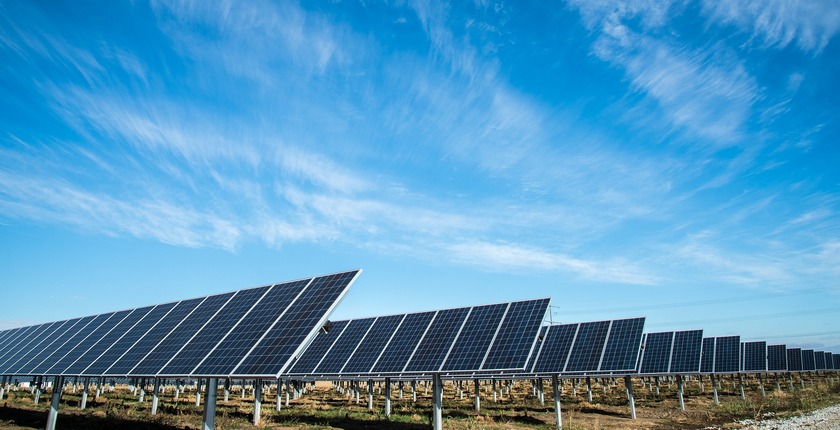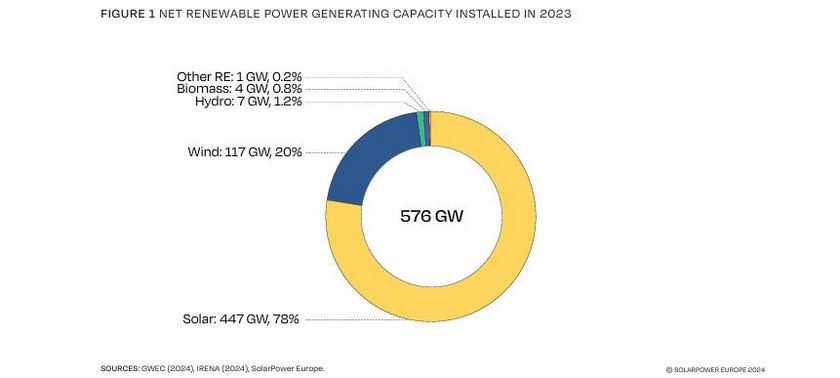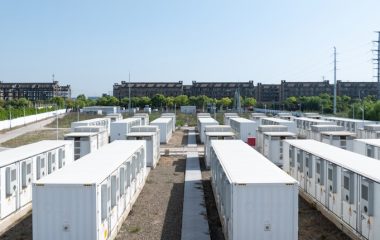
Photo: solarpanal355 from Pixabay
New solar power installations around the world grew 87% year on year in 2023, bringing the total capacity worldwide to 1.6 TW. The technology continued to lead other renewables in nominal terms, accounting for 78% of the total renewable energy installations globally in 2023, according to a new report by SolarPower Europe.
In 2023, the world added 447 GW of solar capacity, compared to the 239 GW installed in 2022. By the end of this year, the total capacity could climb to 2 TW, according to SolarPower Europe’s annual Global Market Outlook for Solar Power 2024-2028.
Last year’s new installations could cover the combined annual electricity consumption of Sweden, the Netherlands, Belgium, Finland, the Czech Republic, Austria, Portugal, and Greece, according to SolarPower Europe.
“The world has truly entered its solar age. The sky is no longer the limit,” said Walburga Hemetsberger, CEO of SolarPower Europe. “How far solar can go will be determined by equitable global access to financing, and the political will to deliver flexible energy systems fit for the renewable reality,” she noted.

Solar power’s share of new renewable electricity capacity increased by 12 percentage points to 78% in 2023. In 2021, it amounted to 56%, according to the report.
Solar’s annual growth rate could reach 1 TW by 2028 if there is enough financing and system flexibility
By 2028, the annual solar growth rate could reach 1 TW, provided that the necessary financing and energy system flexibility, through vast amounts of battery storage capacities, are ensured. To achieve the global target of tripling renewables by 2030, it is necessary to invest USD 12 trillion globally, SolarPower Europe said.
Top 10 markets accounted for most of new solar
When it comes to the 2023 growth, as much as 80% of the new photovoltaic installations were in the top 10 markets, which mainly include advanced economies. China dominated solar growth in 2023, accounting for 57% of the total global installations. Its cumulative solar capacity jumped to 656 GW by the end of 2023, from over 400 GW in 2022.
The leaderboard is disproportionately drawn from advanced economies, according to SolarPower Europe. “While the number of advanced solar markets – installing at least 1 GW annually – grew in 2023 to reach 31 countries, up from 28 in 2022, the list does not heavily feature emerging economies,” it noted.
The United States had its best solar year ever, as Germany doubled new installations
The United States saw its best year for solar ever, installing 32.4 GW in 2023, a 48% boost from 2022. In Europe, Germany took over the lead from Spain, with 15 GW of solar added in 2023, up from 7.4 GW in 2022.
Among the other established solar markets, Spain added 8.9 GW, followed by Italy (5.2 GW), the Netherlands (4.9 GW), Poland (4.6 GW), and France (3.2 GW). At the same time, several other European countries passed the annual gigawatt-market threshold, including Turkey (2.7 GW) and Austria (2.7 GW), with impressive growth rates, of 69% and 166%, respectively.
The EU’s solar growth in 2023 was 50%
Overall, the European Union registered 50% growth last year, with 26 out of 27 of its member states installing more solar than the year before. Among the non-EU European markets, the United Kingdom and Switzerland also continued their upward trend, expanding by 1.8 GW and 1.5 GW respectively.
Among the markets tracked by Balkan Green Energy News, three more were in the gigawatt-scale group, the ones adding more than 1 GW of new capacity. They are Greece, which installed 1.6 GW in 2023, Romania (1.5 GW), and Bulgaria (1.2 GW).









Be the first one to comment on this article.